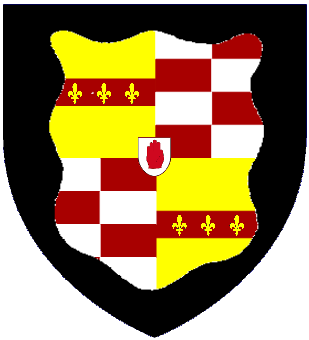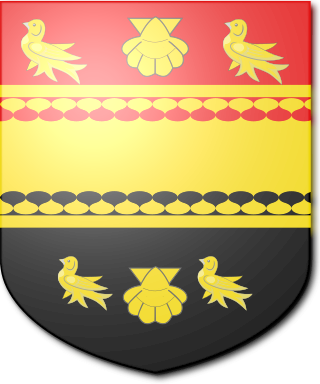
Viscount Hardinge, of Lahore and of Kings Newton in the County of Derby, is a title in the Peerage of the United Kingdom. It was created in 1846 for the soldier and Tory politician Sir Henry Hardinge. His son, the second Viscount, represented Downpatrick in Parliament. His great-great-grandson, the sixth Viscount, succeeded a distant relative as eighth Baronet, of Belle Isle in the County of Fermanagh, in 1986. This title had been created in the Baronetage of the United Kingdom 1801 for Richard Hardinge. He was the third son of Nicolas Hardinge, younger brother of Reverend Henry Hardinge and uncle of the latter's third son Henry Hardinge, 1st Viscount Hardinge. The baronetcy was created with special remainder to the heirs male of Richard Hardinge's father.

The Anson baronetcy, of Birch Hall in the County Palatine of Lancaster, is a title in the Baronetage of the United Kingdom held by a branch of the Anson family. It was created on 30 September 1831 for William Anson. He was the third son of George Anson; his elder brothers were Thomas Anson, 1st Viscount Anson, and General Sir George Anson. Sir William was the uncle of Thomas Anson, 1st Earl of Lichfield, and Major-General George Anson and the great-nephew of George Anson, 1st Baron Anson. His grandson, the third Baronet, was a lawyer and Liberal Unionist politician. He never married and was succeeded by his nephew, the fourth Baronet. He was the only son of Frederick Arthur Anson, third son of the second Baronet. The fourth baronet drowned in the Thames on an outing of The Coterie in July 1914, after he jumped into the river encouraged by lady Diana Manners. He had not married and on his death the title passed to his first cousin, the fifth Baronet, the eldest son of Rear-Admiral Algernon Horatio Anson (1854–1913), fourth and youngest son of the second Baronet. He was killed in action in the First World War. He was unmarried and was succeeded by his younger brother, the sixth Baronet. His elder son, the seventh baronet, was a Rear-Admiral in the Royal Navy. As of 2021 the title is held by the latter's son, the eighth Baronet, who succeeded in 2018.

The Barrett-Lennard Baronetcy, of Belhus in the County of Essex, is a title in the Baronetage of the United Kingdom. It was created on 30 June 1801 for Thomas Barrett-Lennard, subsequently Member of Parliament for Essex South. He was the illegitimate son and testamentary heir of Thomas Barrett-Lennard, 17th Baron Dacre. He was succeeded by his grandson, the second Baronet, the son of Thomas Barrett-Lennard, Member of Parliament for Maldon. His son, the third Baronet, was childless and was succeeded by his younger brother, the fourth Baronet. This line of the family failed on the death in 1977 of his son, the fifth Baronet, who died without male issue. The late Baronet was succeeded by his third cousin once removed, the sixth Baronet. He was the son of Sir Fiennes Cecil Arthur Barrett-Lennard, Chief Justice of Jamaica, son of Captain Thomas George Barrett-Lennard, son of the first marriage of George Barrett-Lennard, son of John Barrett-Lennard, second son of the first Baronet. The sixth Baronet was a Catholic clergyman. As of 2014 the title is held by his second cousin, the seventh Baronet, who succeeded in 2007. He is the grandson of Trenchard Barrett-Lennard, son of the aforementioned George Lennard-Barrett by his second marriage. As of 31 December 2013 the present Baronet has not successfully proven his succession and is therefore not on the Official Roll of the Baronetage, with the baronetcy considered vacant since 2007.

The Blennerhassett Baronetcy of Blennerville in the County of Kerry, is a title in the Baronetage of the United Kingdom. It was created on 22 September 1809 for the Anglo-Irish lawyer Rowland Blennerhassett, He was from a family originally from Cumberland, England, that settled in County Kerry during the reign of James I and represented County Kerry and Tralee in the Irish House of Commons.
The Greenaway Baronetcy, of Coombe in the County of Surrey, is a title in the Baronetage of the United Kingdom. It was created on 23 October 1933 for Percy Walter Greenaway. He was Chairman of Daniel Greenaway & Sons, printers and stationers, and served as Lord Mayor of London from 1932 to 1933. As of 2015 the title is held by his great-grandson, the fourth Baronet, who succeeded his father in that year.

The Chance Baronetcy, of Grand Avenue in the parish of Hove in the County of Sussex, is a title in the Baronetage of the United Kingdom. It was created on 19 June 1900 for James Timmins Chance, a grandson of William Chance one of the Chance brothers who started the family business in 1771. He became head of Chance Brothers and Company. He was High Sheriff of Staffordshire in 1868.

The Beecham Baronetcy, of Ewanville in the Parish of Huyton in the County Palatine of Lancaster, is a title in the Baronetage of the United Kingdom. It was created on 17 July 1914 for the Lancashire pill manufacturer Joseph Beecham. Joseph was succeeded by his eldest son, Thomas, a conductor who founded the London Philharmonic Orchestra in 1932.
There have been four baronetcies created for persons with the surname Bell, all in the Baronetage of the United Kingdom. One creation is extant as of 2007.

The Baynes Baronetcy, of Harefield Place in the County of Middlesex, is a title in the Baronetage of the United Kingdom. It was created on 29 June 1801 for Christopher Baynes. He was Major-Commandant of the Uxbridge Gentlemen and Yeomanry Cavalry, which he helped to raise. The title descended from father to son until the death of his great-great-grandson, the fifth Baronet, in 1971. The late Baronet died unmarried and was succeeded by his first cousin, the sixth Baronet. He was the son of Reverend Malcolm Charles Baynes, fourth son of the third Baronet. As of 2023 the title is held by his grandson, the eighth Baronet, who succeeded his father in 2005.
The Buchan-Hepburn Baronetcy, of Smeaton-Hepburn in the County of Haddington, is a title in the Baronetage of the United Kingdom. It was created on 6 May 1815 for George Buchan-Hepburn. He was a Judge of the Admiralty Court from 1790 to 1791 and a Baron of the Exchequer for Scotland from 1791 to 1814. Born George Buchan, he assumed by Royal licence the additional surname of Hepburn in 1764, which was that of his maternal grandfather. His grandson, the third Baronet, represented Haddington in the House of Commons from 1838 to 1847. His son, the fourth Baronet, was a deputy lieutenant of Haddingtonshire. On the death of his grandson, the sixth Baronet, in 1992, the line of the eldest son of the second Baronet failed. The late Baronet, stepfather of the Duchess of Northumberland, was succeeded by his third cousin, the seventh holder of the title. He was succeeded by his grandson in 2022. The family surname is pronounced "Bukkan-Hebburn".
The Lea Baronetcy, of The Larches in Kidderminster in the County of Worcester and Sea Grove in Dawlish in the County of Devon, is a title in the Baronetage of the United Kingdom. It was created on 6 October 1892 for Thomas Lea, Member of Parliament for Kidderminster, County Donegal and South Londonderry. The family descends from William Butcher, who in 1792 married Elizabeth, daughter of Francis Lea. Their son George Butcher assumed by Royal licence the surname of Lea in lieu of his patronymic in 1834. His son was the first Baronet.
There have been two baronetcies created for persons with the surname Gibbons, one in the Baronetage of Great Britain and one in the Baronetage of the United Kingdom. One creation is extant as of 2012.
The Jervoise, later Clarke-Jervoise Baronetcy, of Idsworth in the County of Southampton, was a title in the Baronetage of the United Kingdom. It was created on 13 November 1813 for Rev. Samuel Jervoise, born Samuel Clarke, who assumed the surname of Jervoise by royal licence in 1808.
The Montgomery baronetcy, of Stanhope in the County of Peebles, was created in the Baronetage of the United Kingdom on 16 July 1801 for the Scottish lawyer and politician James Montgomery. The second Baronet represented Peeblesshire in Parliament. The third Baronet represented both Peebles and Peebles and Selkirk in Parliament. He assumed the additional surname of Graham. The seventh Baronet was Lord-Lieutenant of Kinross-shire. He assumed the surname of Purvis-Russell-Montgomery in 1906 and Purvis-Russell-Hamilton-Montgomery in 1933. The eighth and ninth Baronet have used the surname Montgomery only. The ninth Baronet was Lord-Lieutenant of Perth and Kinross.

The Barlow baronetcy, of Wimpole Street in St Marylebone in the County of London, was created in the Baronetage of the United Kingdom on 20 February 1902 for the physician Thomas Barlow. He was succeeded by his eldest son Alan Barlow, the second Baronet, who was a prominent civil servant. Commodore Sir Thomas Erasmus Barlow, DSC DT took the title in 1968. On his death in 2003 the title was passed to the fourth Baronet, Sir James Alan Barlow.

The Green Baronetcy, of Belsize Park Gardens in the Metropolitan Borough of Hampstead in the County of London, was created in the Baronetage of the United Kingdom on 19 December 1901 for Frank Green, Lord Mayor of London from 1900 to 1901. The title became extinct on the death of the fourth Baronet in 1959.

The Corbet baronetcy, of Moreton Corbet in the County of Shropshire and of Linslade in the County of Buckingham, was created in the Baronetage of the United Kingdom on 3 October 1828 for Andrew Corbet. He was a descendant of Richard Corbet of Shawbury, brother of Sir Vincent Corbet, 1st Baronet of the 1642 creation.

The Russell baronetcy, of Swallowfield in the County of Berkshire, was created in the Baronetage of the United Kingdom on 10 December 1812 for Henry Russell. He was Chief Justice of Bengal and was admitted to the Privy Council in 1816. The 3rd Baronet represented Berkshire and Westminster in the House of Commons as a Conservative and was also awarded the Victoria Cross. The 4th Baronet sat as a Conservative Member of Parliament for East Berkshire. The 6th Baronet was a noted mineralogist.

The Jackson baronetcy, of Arlsey in the County of Bedford, was created in the Baronetage of the United Kingdom on 22 May 1815 for John Jackson. He was a Director of the Honourable East India Company and also represented Dover in the House of Commons.

The Jackson baronetcy, of The Manor House in Birkenhead, was created in the Baronetage of the United Kingdom on 4 November 1869 for William Jackson, Liberal Member of Parliament for Newcastle under Lyne and Derbyshire North. The 2nd Baronet briefly represented Coventry in Parliament.